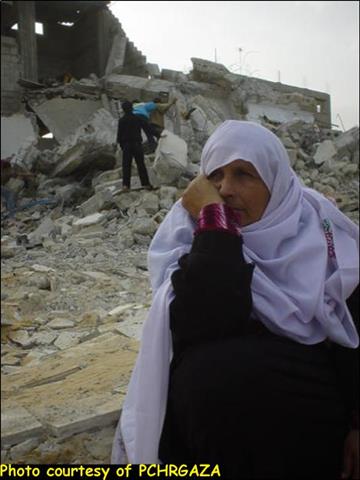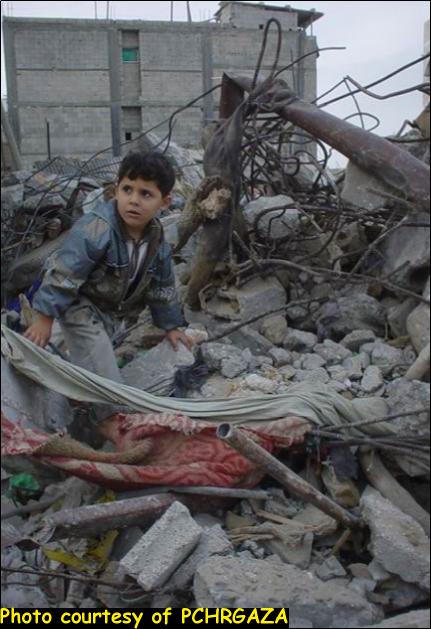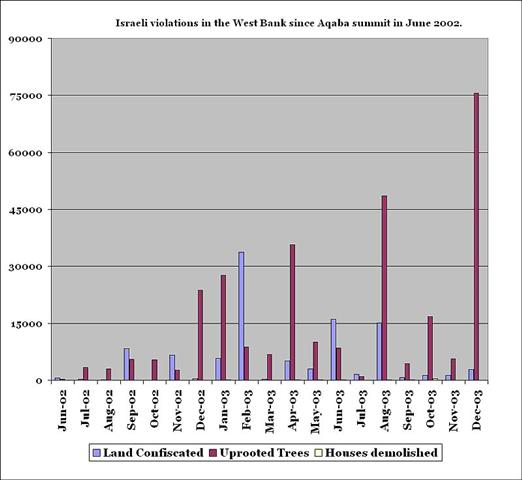In cooperation with PCHRGAZA
( The Palestinian Center for Human Rights) ( The Palestinian Center for Human Rights)
Gaza Strip is one of the most densely populated areas in the world; approximately 1.3 million Palestinians live on 58% of the total of 365 square kilometers that constitute the geographical area of Gaza Strip. The remaining 42% (180 square kilometers) is controlled by the Israeli authorities where illegal settlements, bypass roads and buffer zones around the settlements are built.
Since the outbreak of the second Intifada in September 28, 2000, Gaza Strip has been facing series of violations committed by the Israeli Occupation Forces (IOF) resulting in a huge campaign of house demolitions and confiscation of land. According to a report issued by the Ministry of Public Works and Housing, nearly 60,000 Palestinian houses were demolished by the Israeli Occupying Forces (IOF) in the West Bank and Gaza Strip, of which 55344 houses were partially destroyed, and 4867 were completely demolished. See photo 1, photo 2, photo 3,
The Israeli Policy of house demolition
The demolition of houses and confiscation of agricultural land caused devastating damages to the livelihood of the Palestinian population. Many Palestinians live with the daily fear and threat that their land or their houses will be razed or demolished at anytime. Chart 1 and Chart 2 demonstrate the Israeli violations of house demolition in Gaza Strip during the year 2003:
Chart 1: Number of houses completely demolished in Gaza Strip:
Source: The Palestinian center for human rights (PCHRGAZA) data base
Chart 1 shows that Rafah governorate has the highest number of houses demolished throughout the year. Thousands of Palestinian families are now considered homeless due to the Israeli collective punishment which is still typified by a set of violations. See photo 4, photo 5 & photo 6
The Israeli government undermined all signed agreements through its continuous aggressions on the Palestinians and their properties and undermined all the implementation of all peace agreements mainly the Fourth Geneva Convention in 1949 'article 33, first Paragraph that lays: a prohibition on collective punishments of any kind inflicted on persons or entire groups in defiance of the most elementary principles of humanity, for acts these persons have not committed and all measures of intimidation or terrorism with regard to protected persons, whatever they may be. Thus, strike at guilty and innocent alike is opposed to all principles based on humanity and justice'.
. Chart 2: Number of houses partially damaged in Gaza Strip:

Source: The Palestinian center for human rights (PCHRGAZA) data base
Rafah town and refugee camp located in the south of the Gaza Strip and adjacent to the Egyptian borders, has been the focus of the Israeli policy of house demolition. The Israeli army always claimed that these operations are conducted under security reasons. Demolitions often take place at night without pre-notification, when the Israeli military bulldozers move into the Palestinian cities or camps and cause severe damages to the properties; Usually Palestinians aren't given enough time to salvage their furniture and personal belongings leaving them in poor living conditions.
According to the report issued by the ministry of public works and housing, the Palestinian authority is incapable of rebuilding what has been destroyed by the Israelis. An estimation of $ 400 million is needed by the PLO to save the housing sector from degradation.
On Tuesday 20 January 2004, the Israeli forces backed by tanks and heavy bulldozers and under heavy barrage of gunfire invaded Yibna refugee camp and Al Barahima area on the Palestinian- Egyptian borders and completely demolished about thirty houses turning them into a heap of rubble. Among the owners, the following were known: Table 1: Names of owners of demolished houses:
|
No. |
Name |
|
1. |
Hamad Hamdan Qishta |
|
2. |
Muhammad Hamdan Qishta |
|
3. |
Ibrahim Sa'id Qishta |
|
4. |
Hamdan Sa'id Qishta |
|
5. |
Muhammad Salameh Qishta |
|
6. |
Sa'id Salameh Qishta |
|
7. |
Farid Hassan Qishta |
|
8. |
Hisham Hassan Qishta |
|
9. |
Mas'oud Salameh Qishta |
|
10. |
Husam Mahmoud Al Sha'ir |
|
11. |
Faraj Suleiman Qishta |
|
12. |
Hamdan Suleiman Qishta |
|
13. |
Muhammad Suleiman Qishta |
|
14. |
'Ilaian Suleiman Qishta |
|
15. |
Muhammad Hamdan Suleiman Qishta |
|
16. |
Ibrahim Sa'id Qishta |
|
17. |
'Abed Allah Qishta, Muhammad |
|
18. |
Hamdan Qishta |
|
19. |
Mazyouna Hassan Qishta |
|
20. |
Mahmoud 'Ali Qishta |
|
21. |
Salah Salim Al Sha'ir Shtewi Hamdan Qishta |
Destroying of Palestinian agriculture
Agricultural lands and fruitful trees have been systematically uprooted and razed in all Palestinian territories for the Israeli military purposes, particularly since the beginning of the second Intifada and for the construction of the Segregation Wall which affected negatively the Palestinian communities and their economy.
Destruction of Palestinian agricultural sector, including uprooting of trees, destruction of crops, denying of access to agricultural land and equipments, are imposed by the Israeli occupying forces as a collective punishment against Palestinians. Gaza Strip has surveyed many of the Israeli violent measures against land and agriculture; especially during the year 2003. Chart 3 shows the number of dunums razed in Gaza Strip during the year 2003.
Chart 3: Number of dunums razed in Gaza Strip:

Source: The Palestinian center for human rights (PCHRGAZA) data base
Going on with its policy, the IOF handed on Monday, 19th of January, 2004, Palestinian families in Deir El Balah military orders to confiscate about 700 dunums of agricultural land located northeast of 'Kfar Darom' settlement. According to landowners, the Israeli soldiers informed them orally that the land will be confiscated and used to construct part of the Segregation Wall around the aforementioned settlement. Among the landowners, Al 'Azayzeh, Abu Samra, Abu Bashir, Al Flit, Abu Msabeh, Al Ma'ni, Abu Jarer and Abu Baraka families were known.
Israel continues to devour the Palestinian agricultural land to construct the so called 'Segregation Wall as well as expanding settlements borders on the expense of the Palestinian lands.
Related articles:
-
A fall from Grace … Al Zahra building towers victims of the Israeli explosives. November 2003.
-
An analysis on the recent geopolitical situation in the Gaza Strip, September 2003.
Prepared by:
The Applied Research Institute – Jerusalem




















